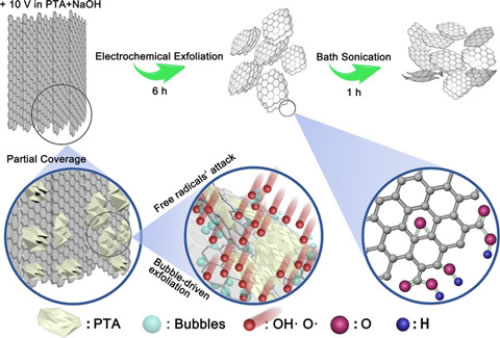
Preparation of Water-soluble Graphene by Electrochemical Stripping Method Based on Molecular Adsorption Protection and Full Oxidation
The graphene material is attributed to its excellent physicochemical properties (high mobility mobility at room temperature up to 15000 cm2/V•s, high thermal conductivity: 5000 W/m•K, Young's modulus: 350 N/m, etc.) Widely used in lithium ion batteries, sensing, energy storage materials, and biomedicine and many other fields. Therefore, the low-cost, large-scale preparation and effective dispersion of graphene materials are prerequisites for the realization of these applications and have become important topics for scientific research. Currently, cheap graphite is used as a raw material, and graphene materials can be mass-produced through interlayer intercalation and stripping of graphite. There are still problems such as low yield, poor environmental protection of the prepared system, and poor safety. At the same time, due to the role of van der Waals forces, the product graphene is prone to overlap and aggregation, and the surface energy does not match, which makes it difficult to disperse graphene in aqueous solutions or other low-boiling organic solvents, which greatly affects graphite. Practical application of olefinic materials. Therefore, the development of green, high-efficiency, low-cost new methods to make graphene better dispersed in aqueous solutions or other low-boiling organic solutions is an important research topic in the field of graphene materials.
Recently, researchers from Graphene Powder Materials Research Institute of Shanghai Institute of Microsystem and Information Technology, Chinese Academy of Sciences, Ding Guqiao and He Peng have made progress in the preparation of water-soluble graphene materials: based on innovative electrochemical technology and ultrasonic-assisted dispersion. Mechanisms for the preparation of low-concentration, high-concentration, water-soluble graphenes in a mixed electrolyte system of NaOH and PTA have been published online in Green Chemistry. In this system, the researchers controlled the electrochemical process to precipitate and adsorb PTA on the graphite electrode, which promoted the full oxidation of the graphite and layer-by-layer exfoliation. Subsequently, ultrasound treatment was used to further increase the yield, achieving a high yield (87.3%). The preparation of high-solids (8.2 g/L) and high-stability (more than 8 months) micron-sized water-soluble graphenes has obvious advantages over existing studies. At the same time, due to the electrochemical anode molecular adsorption protection mechanism, the sp2 structure of the product sheet is preserved. After the film is formed, high electrical conductivity (9517 S/m) can be obtained by thermal reduction at a relatively low temperature, and the application potential is huge. . Further mechanistic studies have clarified that the electrochemical mechanism is different from the previous intercalation, oxidation, expansion, and exfoliation. The new electrochemical mechanism of layer-by-layer exfoliation and deeper oxidation overcomes the inconsistency of the product layer due to incomplete stripping of conventional electrochemical methods. Low, poor dispersion and other issues. At the same time, further studies have determined the effect of ultrasound in different environments, different treatment times, and different precursor conditions, and have important guiding significance for the process improvement in subsequent studies. The prepared water-soluble graphene is easy to form into a film, and has the advantages of low voltage, high-speed heating and good temperature consistency in terms of electric heating, and is expected to be popularized and applied as a new type of electric heating material.
The research team is dedicated to the innovative preparation and application of graphene materials, and has vigorously developed original preparation techniques to obtain high-end graphene materials such as high-quality graphene, water-soluble graphene, and graphene quantum dots. The related research has received major national science and technology. Special projects, National Natural Science Foundation projects, and Chinese Academy of Sciences support for strategic pilot projects.
The fuel level sensor is fully developed and manufactured by GAMICOS for universal fuel management – monitoring fuel level, controlling fuel consumption and preventing fuel theft. According to different case, we can offer Reed Switch Fuel Level Sensor, mechnical fuel level gauge, Capacitive Fuel Level Sensor and ultrasonic fuel level sensors etc.
Fuel Level Sensor,Fuel Level Gauge,Fuel Tank Level Sensor, Diesel Level Sensor, Mechnical Fuel Level Gauge, Capacitive Fuel Level Sensor
Xi'an Gavin Electronic Technology Co., Ltd , https://www.cngamicos.com